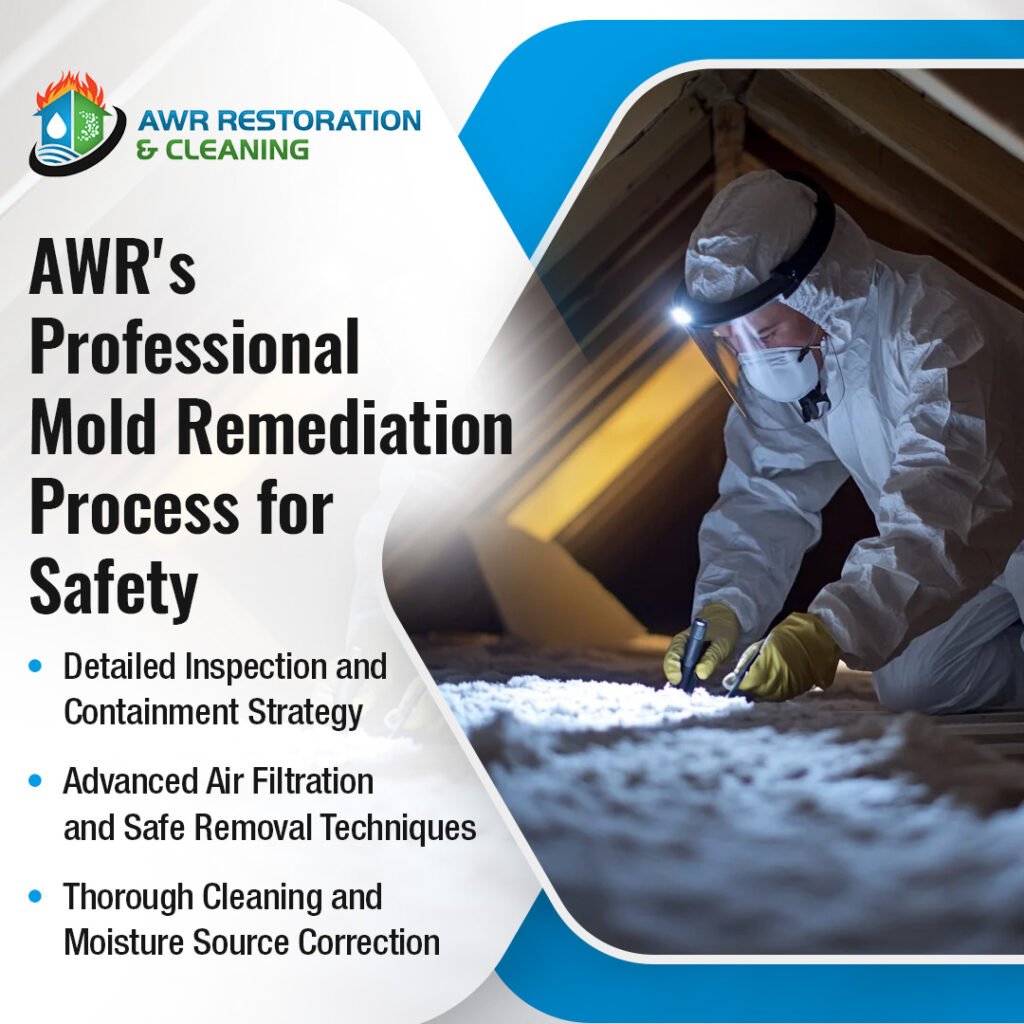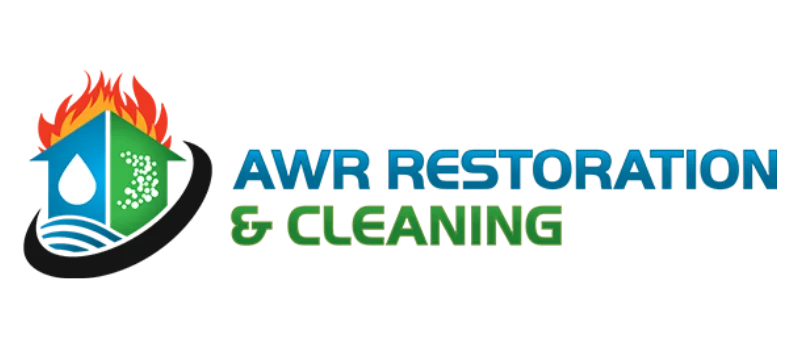Finding mold in homes or businesses often causes immediate concern. When that mold appears dark or black, the worry can intensify. Thoughts often turn to “black mold,” a term commonly linked to potential health problems. While many types of mold can appear black, the species Stachybotrys chartarum is often the focus of concerns due to its ability to produce mycotoxins under specific conditions. Significant mold growth of any type is undesirable, as it can cause property damage and affect indoor air quality.
This blog clarifies the risks associated with Stachybotrys chartarum, explains why attempting mold removal on your own can be hazardous, and details the safe and methodical mold remediation process used by AWR Restoration & Cleaning for residents and businesses in the Meredith area.

Understanding Black Mold: Beyond Just the Color
Getting factual information about black mold helps property owners respond appropriately if they suspect its presence.
Identifying “Black Mold” (Stachybotrys chartarum)
Stachybotrys chartarum is a specific species of microfungus. It typically appears greenish-black and often has a slimy texture when wet, due to a layer of moisture on its surface. If its water source dries up, it can appear dry, sooty, or powdery. It is important to remember that many other common indoor molds, like some species of Cladosporium or Aspergillus, can also appear black or very dark. Therefore, identifying mold based purely on its color is unreliable. Stachybotrys requires constant, high moisture levels to grow and is often found on cellulose-rich materials like wood, fiberboard, gypsum board, drywall, paper, dust, and lint.
Why is Stachybotrys Considered a Concern? The Role of Mycotoxins
The concern surrounding Stachybotrys stems from its ability to produce mycotoxins – toxic chemical compounds produced naturally by certain fungi. Not all molds produce mycotoxins, and even those that can don’t produce them under all conditions. When Stachybotrys spores or fragments containing mycotoxins are inhaled, ingested, or come into contact with skin, they can potentially cause health effects in some individuals. Reported symptoms sometimes associated with exposure to Stachybotrys mycotoxins may include respiratory problems, nasal congestion, eye irritation, skin rashes, headaches, and fatigue. It’s worth repeating that individual sensitivity varies greatly, and not everyone exposed will experience health problems. The presence of mold, regardless of type, can also trigger allergic reactions in sensitive individuals.
Common Hiding Spots for Black Mold in Meredith Properties
Stachybotrys needs persistent moisture. In Meredith, properties often have this type, which means they are often found in areas prone to dampness or water damage. Common locations include damp basements and crawl spaces, areas around plumbing leaks, poorly ventilated bathrooms, window sills where condensation collects, and behind drywall or under flooring following a flood or leak. Meredith’s climate, with periods of high humidity and rainfall, can contribute to moisture problems indoors if buildings are not well-maintained or adequately ventilated, creating environments where mold, including Stachybotrys, can establish itself.
Why Professional Assessment is Important
Because visual identification of mold species is unreliable, a professional assessment is valuable. While laboratory testing can identify specific mold types, including Stachybotrys, the standard practice for mold remediation generally focuses on removing visible mold growth and correcting the moisture conditions that allowed it to grow, regardless of the identified species. Professionals use tools like moisture meters to locate hidden dampness and determine the extent of the problem, which informs the mold removal strategy..
The Serious Risks of DIY Black Mold Removal Attempts
While tackling a small spot of ordinary mildew might seem manageable, attempting to remove a suspected Stachybotrys infestation without professional training and equipment is highly discouraged due to several serious risks.
Spore Dispersal: Making the Infestation Worse
Mold colonies, especially dry ones, release countless microscopic spores when disturbed. Activities like scrubbing, sanding, wiping, or tearing out contaminated materials without proper controls can send these spores airborne. These spores then travel easily through the air, settling on surfaces in previously unaffected areas of the property and potentially starting new mold colonies wherever sufficient moisture is present. A poorly handled mold removal attempt can spread the contamination far beyond the initial area.
Cross-Contamination via HVAC and Foot Traffic
Airborne spores generated during improper removal can readily enter a building’s heating, ventilation, and air conditioning (HVAC) system. Once inside the ductwork, the system can quickly distribute spores throughout the entire property. Spores can also attach to clothing, shoes, and tools, and be carried from a contaminated area to a clean one by unsuspecting individuals, leading to cross-contamination. Professionals prevent this using containment barriers and controlled airflow.
Health Risks from Inadequate Personal Protective Equipment (PPE)
Attempting to remove mold, particularly potentially toxigenic molds like Stachybotrys, without adequate personal protective equipment PPE poses direct health risks. Inhaling high concentrations of spores and mycotoxins can lead to respiratory irritation or trigger allergic reactions. Proper respiratory protection, typically involving N95 respirators or half-face or full-face respirators with suitable cartridges, is necessary. Skin contact should also be avoided by using gloves, eye protection, and disposable full-body suits. Homeowners rarely possess or use the correct level of PPE, risking exposure.
Failing to Eliminate the Moisture Source: A Recipe for Return
One of the most common failures of DIY mold removal is neglecting the underlying cause. Mold needs moisture to survive and grow. Simply cleaning or removing the visible mold without addressing the underlying issues, such as fixing the water leak, reducing high humidity, or improving poor ventilation, is futile. The mold will almost certainly return if the moisture conditions persist. Effective mold remediation always includes addressing the water problem.
Improper Disposal Creates Further Hazards
Mold-contaminated building materials cannot be thrown away in the regular trash without taking precautions. They should be carefully contained, often double-bagged in heavy-duty plastic bags, before being removed from the property. Specific local regulations also apply to the disposal of moldy materials. Improper handling during disposal can release spores again.
AWR Restoration and Cleaning’s Professional Black Mold Remediation Protocol
We at AWR Restoration and Cleaning, follows established industry standards and protocols for safe and effective mold remediation, particularly when dealing with suspected Stachybotrys or extensive contamination.
Step 1: Conduct A Thorough Inspection And Create A Mold Remediation Plan.
The process begins with a detailed inspection of the property. Our technicians visually examine affected areas, identify the extent of visible mold growth, and work to pinpoint the source(s) of moisture feeding the mold. They may use moisture meters, thermal imaging cameras, or other diagnostic tools to detect hidden dampness within walls, floors, or ceilings. Based on these findings, a specific mold remediation plan is developed, outlining the containment strategy, removal procedures, and cleaning methods appropriate for the situation.
Step 2: Containment – Critical for Safety
Before any mold removal begins, the affected area is isolated from the rest of the property. This involves setting up containment barriers, typically using heavy plastic sheeting sealed with tape over doorways, vents, and other openings. To prevent spores from escaping the work zone, negative air pressure is often established within the containment area using specialized air filtration devices vented outdoors. This ensures air flows into the contained space but not out.
Step 3: Air Filtration Throughout the Process
During the entire mold removal and cleaning process, High-Efficiency Particulate Air (HEPA) filtration units, also known as air scrubbers, run continuously within the containment zone. These machines capture microscopic airborne particles, including mold spores, preventing them from spreading and helping to clean the air. HEPA filters are designed to trap particles as small as 0.3 microns with very high efficiency.
Step 4: Safe and Methodical Mold Removal.
The actual mold removal process depends on the type of material affected. Porous materials that are heavily contaminated, such as drywall, insulation, carpet, and ceiling tiles, usually cannot be effectively cleaned and must be carefully removed. Our technicians cut away and bag these materials within the containment area. Non-porous materials, like metal or glass, and semi-porous materials, like wood framing or concrete, can often be cleaned. This involves methods like wire brushing, damp wiping, sanding using dust control measures, or using specialized equipment like HEPA vacuums designed to capture fine particles during cleaning.
Step 5: Cleaning, Disinfecting, and Treating Surfaces.
After removing the mold growth and contaminated materials, the remaining surfaces within the containment area are thoroughly cleaned. This typically involves damp wiping with specialized cleaning solutions. Depending on the situation and remediation plan, EPA-registered disinfectants or antimicrobial treatments formulated for mold remediation might be applied to kill any remaining mold spores and help prevent future regrowth on treated surfaces.
Step 6: Addressing the Underlying Moisture Problem.
This step is fundamental to the long-term success of the mold remediation. AWR Restoration and Cleaning works with the property owner to make certain the source of moisture – whether a plumbing leak, roof leak, foundation issue, high humidity, or poor ventilation – is identified and properly repaired or corrected. Without fixing the water problem, any mold removal effort will likely fail in the long run.
Step 7: Post-Remediation Procedures
Once cleaning and drying are complete, the containment barriers are carefully removed. A final visual inspection of the work area is conducted. In some situations, particularly for large-scale remediations or when specific health concerns exist, post-remediation verification sampling performed by an independent environmental professional may be recommended to confirm the remediation’s effectiveness.
Why Meredith Residents Trust AWR Restoration and Cleaning for Toxic Mold Challenges
Choosing a qualified professional is paramount when dealing with mold, especially potentially toxigenic types. At AWR Restoration and Cleaning, we offer several advantages for Meredith property owners.
Certified Expertise and Local Experience
AWR Restoration and Cleaning is an IICRC Certified Firm. This certification demonstrates adherence to industry-accepted standards for mold remediation. Combined with years of practical experience addressing mold issues specifically within the Meredith area and its unique environmental conditions, this provides a strong foundation of technical knowledge.
Uncompromising Safety Standards
We prioritize the safety of building occupants and its technicians. This is reflected in the rigorous use of containment procedures, negative air pressure, HEPA filtration, and appropriate Personal Protective Equipment (PPE) during all phases of the mold removal and mold remediation process. Safe work practices are consistently applied.
Complete Mold Remediation Approach
At AWR Restoration and Cleaning, we address the mold problem comprehensively. The service includes not only mold removal but also a thorough assessment, effective containment, detailed cleaning, proper disposal, and a focus on identifying and correcting the underlying moisture source that allowed the mold to grow in the first place.
Use of Professional Equipment.
Effective and safe mold remediation requires specialized equipment. We utilize professional-grade tools, including negative air machines, HEPA air scrubbers, specialized HEPA vacuums, moisture detection instruments, and appropriate cleaning and disinfecting agents, which are necessary for properly handling challenging mold infestations.
Tips for Preventing Mold Growth in Your Meredith Home or Business
While professional help is needed for existing infestations, property owners can take steps to minimize the risk of future mold growth.
- Maintain Optimum Humidity Levels: Aim for indoor humidity between 30% and 50%. Use dehumidifiers in areas with high humidity, such as basements.
- Address Water Leaks Immediately: Fix plumbing leaks, roof leaks, or seepage problems as soon as they are discovered.
- Assure Adequate Ventilation: Use exhaust fans in bathrooms and kitchens to vent moisture outside. Check that attics and crawl spaces are properly ventilated.
- Clean and Dry Wet Areas Promptly: Clean up spills and dry any wet areas within 24-48 hours to prevent mold spores from establishing.
- Conduct Regular Visual Checks: Periodically inspect areas prone to moisture, like bathrooms, kitchens, basements, and window frames, for any signs of mold growth or water stains.

Prioritize Safety with Professional Mold Remediation in Meredith
Suspected black mold (Stachybotrys) infestations present genuine risks to both property and, potentially, health. Attempting DIY mold removal often worsens the problem by spreading spores and failing to address the root cause, while also exposing individuals to contaminants without proper protection.
At AWR Restoration and Cleaning, we provide Meredith residents with a safe, methodical, and effective approach to mold remediation. Adhering to industry best practices and using specialized equipment guarantees that the infestation is handled correctly, from containment through final cleaning and moisture source correction. If you suspect black mold in your Meredith property, avoid the risks of DIY. Contact us at (206) 450-0990, info@awrrc.com, or visit our website for a professional inspection and a safe resolution to your mold concerns.

